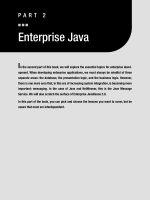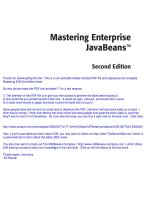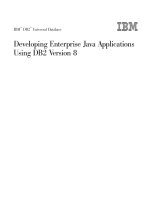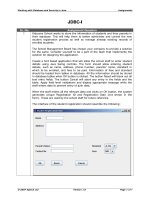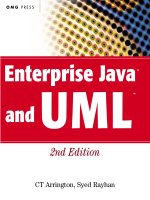Enterprise Java - JDBC Technology
Bạn đang xem bản rút gọn của tài liệu. Xem và tải ngay bản đầy đủ của tài liệu tại đây (295.73 KB, 20 trang )
Enterprise Java
I
n the second part of this book, we will explore the essential topics for enterprise devel-
opment. When developing enterprise applications, we must always be mindful of three
separate areas: the database, the presentation logic, and the business logic. However,
there is one more area that, in this era of increasing system integration, is becoming more
important: messaging. In the case of Java and NetWeaver, this is the Java Message
Service. We will also scratch the surface of Enterprise JavaBeans 3.0.
In this part of the book, you can pick and choose the lessons you want to cover, but be
aware that most are interdependent.
PART 2
■ ■ ■
6250CH19.qxd 2/22/06 5:03 PM Page 95
6250CH19.qxd 2/22/06 5:03 PM Page 96
JDBC Technology
J
ava Database Connectivity (JDBC) is the standard way to connect to an external database
from Java. It uses Structured Query Language (SQL) to access and update the database.
It should be stressed that this is not the only way to access a database. For example,
the IBM AS/400 (iSeries) has an implementation of Java that allows direct database access
through nonstandard IBM APIs. The benefit of this method is that the database access is
incredibly quick (the AS/400 consistently comes out on top as the world’s fastest transaction
server), and it takes advantage of the native database functionality. The drawback is that this
approach sacrifices the “write once, run anywhere” ethos.
JDBC Drivers
JDBC drivers allow the Java programmer to communicate with a database management system
(DBMS). Although some basic drivers are delivered with Java, DBMS vendors supply JDBC
drivers with their systems. These drivers fall into four basic types.
In SAP-land, we have other mechanisms for talking to databases, but Exchange Infra-
structure 3.0 can happily use JDBC.
Type 1 Drivers
Type 1 JDBC drivers are also known as bridge drivers, such as the JDBC-ODBC bridge driver.
These drivers rely on an intermediary, such as ODBC, to transfer the SQL calls to the database.
Bridge drivers often rely on native code, although the JDBC-ODBC library native code is part
of the Java 5 Virtual Machine. It is widely believed that these drivers are much slower than
others, and they are avoided for this reason. Interestingly enough, recent studies have shown
them to be as quick, and sometimes quicker, than other drivers.
These are the drivers we will use in our examples, but please experiment with the other
drivers on your own.
Type 2 Drivers
Type 2 drivers use the existing database API to communicate with the database on the client.
Although Type 2 drivers are generally considered faster than Type 1 drivers, Type 2 drivers use
native code and require additional permissions to work in an applet.
A Type 2 driver might need client-side database code to connect over the network.
97
LESSON 19
■ ■ ■
6250CH19.qxd 2/22/06 5:03 PM Page 97
Type 3 Drivers
Type 3 drivers call the database API on the server. JDBC requests from the client are first prox-
ied to the JDBC driver on the server to run. Type 3 and 4 drivers can be used by thin clients, as
they need no native code.
Type 4 Drivers
The highest level of driver re-implements the database network API in the Java language. Type
4 drivers can also be used on thin clients, as they have no native code.
Loading the Driver
The first step you need to complete before connecting to a database is to load the driver. To do
this, we use the class.forName method.
Here’s how we would load the JDBC-ODBC bridge driver (which comes with the Java SDK):
Class.forName("sun.jdbc.odbc.JdbcOdbcDriver");
It’s a bit long-winded, but we just need to do it once per application.
Remember to put this in a try . . . catch block to take care of any exceptions that may
be thrown.
■
Note
There is another more manual way of loading the JDBC driver, but this technique is used by nearly
all Java programmers.
Connecting to the Database
Since we will be looking at the JDBC-ODBC driver in our examples, you will need to know how
to set up an ODBC connection. I have several in my Windows ODBC Data Sources window, as
you can see in Figure 19-1.
To access this, click on Administrative Tools in your Control Panel (Windows 2000 or XP).
After that, click on Data Sources (ODBC), and you should see something like Figure 19-1.
From here you can add, change, or delete your data sources.
■
Note
The important point here is that the name of the data source in the ODBC Data Source
Administrator window is the name you will use in your program.
LESSON 19
■
JDBC TECHNOLOGY98
6250CH19.qxd 2/22/06 5:03 PM Page 98
Figure 19-1. ODBC data sources
Now we can code our URL to the data source or database. We first define our URL, which
must follow the format jdbc:odbc:xxxxx (where xxxxx is the name of your data source) if we
are using the JDBC-ODBC bridge. (If you are using a JDBC driver provided by a third party,
don’t fret—the URL for the driver is normally well documented.)
Once we’ve done that, we can use the URL to connect by calling the getConnection
method in our DriverManager class. Easy, no? Here’s an example:
String myURL = "jdbc:odbc:userControl";
myCon = DriverManager.getConnection(myURL, "","");
Don’t forget to close your connection when you’ve finished with the database. Here’s an
example:
myCon.close();
Once we have our connection, we can concentrate on building a Statement.
■
Note
The JDBC classes—Connection, Statement, DriverManager, and so on—live in the SQL package,
which must be imported before we can use it. The code samples later in this lesson show how we do this
in Java.
LESSON 19
■
JDBC TECHNOLOGY 99
6250CH19.qxd 2/22/06 5:03 PM Page 99
Creating Statements
With the Statement class, we can do almost anything with a database.
■
Tip
We will be focusing on the Statement class in this section, but I urge you to examine two subclasses
of Statement: CallableStatement and PreparedStatement.
Let’s examine a simple insert. We first create the statement using the createStatement
method in the Connection class instance:
myStat = myCon.createStatement();
This is good so far. Now that we have our Statement instance, we can execute an SQL
string. For this example, imagine we have extracted some booking information from a user
interface—we are going to add this information as a record to a table in our database. The
Table name is registration.
Here’s how we do this:
myStat.execute("INSERT INTO registration (FirstName, LastName, Salutation, email, "+
"RoomType) VALUES ("+ guestData +");");
Don’t forget to close the Statement once you’ve used it. (This is not the same as closing
the Connection.)
myStat.close();
Now that we’ve examined the basics of a table insert, let’s see all the code together. I’ve
included a snippet from a Servlet class I use for training, but please don’t worry about the
Servlet code. I’ve made the important bits bold, and I’ve chopped chunks out of this program,
to make it more readable.
STRUCTURED QUERY LANGUAGE
When Messrs. Boyce and Codd from IBM developed the relational database, they also decided to develop a
natural English-style interface to those relational databases. Thus, SQL was born. SQL stands for Structured
Query Language and is not pronounced “Sequel”—that pronunciation is for a database product from
Microsoft, which is not the same thing at all. I have made the assumption here that you are already familiar
with SQL from your ABAP coding.
LESSON 19
■
JDBC TECHNOLOGY100
6250CH19.qxd 2/22/06 5:03 PM Page 100
/*
* 3-Tier Java example (NOT the Full program!)
*
*
*/
import java.io.*;
import java.sql.*;
import javax.servlet.*;
import javax.servlet.http.*;
import java.util.*;
import javax.mail.*;
import javax.mail.internet.*;
/**
*
* @author Alistair Rooney
*/
public class GuestReservation extends HttpServlet
{
private Statement myStat = null;
private Connection myCon = null;
public void init(ServletConfig config) throws ServletException
{
super.init(config);
try
{
Class.forName("sun.jdbc.odbc.JdbcOdbcDriver");
String myURL = "jdbc:odbc:Guest";
myCon = DriverManager.getConnection(myURL, "","");
}
catch(Exception e)
{
e.printStackTrace();
System.err.println("ERROR: Cannot create a Connection");
myCon = null;
}
}
public void doPost(HttpServletRequest req, HttpServletResponse res)
throws ServletException, IOException
LESSON 19
■
JDBC TECHNOLOGY 101
6250CH19.qxd 2/22/06 5:03 PM Page 101
. . .
//code snipped out that will call submitData, handle HTML, etc.
. . .
private boolean submitData(String guestData)
{
try
{
myStat = myCon.createStatement();
myStat.execute("INSERT INTO registration (FirstName, LastName,
Salutation, email, "+"RoomType) VALUES ("+ guestData +");");
myStat.close();
return true;
}
catch(Exception ex)
{
System.err.println("ERROR: Cannot enter guest into database");
ex.printStackTrace();
return false;
}
}
public void destroy()
{
try
{
myCon.close();
}
catch(Exception ex)
{
System.err.println("ERROR: Cannot CLOSE database");
}
}
}
Notice that I’ve put everything into try . . . catch blocks for decent exception handling.
Updates can also be done using the executeUpdate method.
■
Note
Please be aware that although Java can use some advanced features, the underlying database may
not support those features. For example, there is little point trying to get too clever with an Access DBMS,
since it is a very simple stand-alone database with limited functionality. On the other hand, you would proba-
bly have no problems with Oracle or DB/2, which are enterprise-ready full-function database management
systems.
LESSON 19
■
JDBC TECHNOLOGY102
6250CH19.qxd 2/22/06 5:03 PM Page 102

